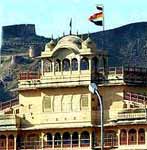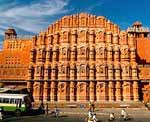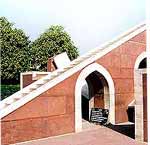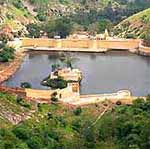This museum is situated in the Chandra Mahal Palace, built by Maharaja Sawai Man Singh, when he constructed his new capital at Jaipur in 1727. The museum dispalys the ancestral collections of former Maharajas, paintings , maps, carpets, textiles costumes, and weapons and decorative art objectsdepicting courtly life in jaipur state between the 16th and 19th century.
aipur, the vibrant capital of Rajasthan, is popularly known as the 'Pink City' because of the pink sandstone used in the buildings of the old walled city. Jaipur owes its name and foundation to the great warrior-astronomer Maharaja Jaisingh II. The Hawa Mahal or palace of the winds is the city's central landmark. It sits on a dry lake bed in a somewhat arid landscape, surrounded by barren hills surmounted by forts and crenelated walls. This buzzing metropolis is certainly a place of wild contrasts and a feast for the eyes. Jaipur has massive forts, magnificent palaces, exquisite temples and marvellous gardens. |
|
 Amber Palace: Amber Palace: |
Ambar palace is situated in Amber, the former capital of the Kachhwaha Rajputs on a hillside overlooking Maotha lake, 11 km from Jaipur on the Delhi - Jaipur road. Its construction was started by Raja Man Singh I, army commander of Mughal Emperor Akbar in 1592 and was completed by Mirza Raja Jai Singh and Sawai Jai Singh, over a period of about two centuries. It is a classic fusion of Mughal and Hindu architecture, built in red sandstone and white marble.  Major Attractions:
Major Attractions:
1. Old Amber Palace
2. Diwan-i-Am or Hall of Public Audience
3. Shila Mata Temple
4. Ganesh Pol & Suhaag Mandir
5. Diwan-i-Khas (Hall of Private Audience), Sukh Niwas, Jai Mandir & Jas Mandir
Location : On Delhi-Jaipur highway, 11 kilometers away from Jaipur
Time to Visit : Open on all days, except Holi
Preferred Timings : 9.30 a.m.- 4.30 p.m. |
|
 City Palace: City Palace: |
Occupying the centre of Jaipur, the City Palace covers one seventh of the city area and the plan of the palace is exactly similar to the plan of the city. The palace has a high wall or the sarahad that surrounds it on all sides. It is a bit confusing to find the main entrance to the palace and can only be arrived at after going through various bazaars (Sireh Deori), past the Town Hall (Vidhan Sabha), passing through the arches of Sireh Deori (boundary gate) also known as the Udai Pol, Naqqar Darwaza (drum gate), the Vijai Pol, Jai Pol, Ganpati Pol and via the Jaleb Chowk. The Town Hall (late 19th century) once housed the State Council. It faces west over Sireh Deorhi bazaar and has a large terrace and verandah. Jaleb Chowk was previously the residence of the Palace Guards. The residential wing of the rajas that were modified in the 19th century by Sawai Ram Singh II surround the chowk on all sides. After crossing the Jaleb Chowk and proceeding through a narrow archway you will reach the Gainda ki Deorhi (rhinoceros gate) and the city palace complex.  Major Attractions:
Major Attractions:
1. Mubarak Mahal
2. The Museum Attractions
3. The Textile and Costume Museum
4. Attraction of The Silver Urns
5. Diwan-i-Aam--The Hall of Public Audience
6. The Peacock Gate |
|
 Hawa Mahal Jaipur: Hawa Mahal Jaipur: |
The Hawa Mahal, or the Palace of Winds, is arguably Jaipur’s best-known monument. For one, it is unlike any other Rajput monument – fort, palace or temple. Secondly, it’s a bit too whimsical and delicate, almost like a magical structure from the Arabian Nights. Despite its towering height and length, the Hawa Mahal looks like a light, airy structure which might blow away with the slightest wind.  Major Attractions:
Major Attractions:
1. Construction of The Palace
2. Constructed For The Royal Ladies of The Court
Visiting hours: 1000-1630 Hrs. Free on Monday and closed on Friday, Still & Vedio Camera charges are also there. |
|
 Jantar Mantar Jaipur: Jantar Mantar Jaipur: |
Jantar Mantar, built between 1728 and 1734, literally means the ‘instruments for measuring the harmony of the heavens’. Jai Singh, the brain behind the grand project, chose stone with marble facing. This was the biggest of all his observatories and the only one built of stone. He used it daily, often with his astronomy gurus Pandit Jagannath and Kewal Ram. In all there are 17 instruments in the Jantar Mantar complex. The function of each instrument is rather complex but serves a particular function where time plays the main theme.  Major Attractions:
Major Attractions:
1. Instruments Used in Jantar Mantar
2. Adequacy of Specific Yantras
Visiting Hours : 0930-1630 Hrs |
|
 Jaigarh Fort: Jaigarh Fort: |
Whenever Man Singh I (late 16th century) or his successors warred and won gold, silver, jewels and other booty, they hoarded it in the Jaigarh Fort. and they had the loyal Minas to fiercely guard their haul. (In fact, legends tell us that the Minas were such strict guards that they let each new Kachhawaha king to enter only once and pick one single piece for himself from the dazzling pile!) Anyway, all this treasure paid first for building Amber, then Jaipur and for centuries of lavish living. Indian Government officials tried to retrieve whatever was left; they dug the place in 1976 but found nothing. In fact they even drained the three arched water tanks (in a courtyard on the way to the northern end of the fort) in the hope of finding the fortune there. Some say that everything was used up in building Jaipur while others claim that it is still there somewhere.  Major Attractions:
Major Attractions:
1. The Location of The Fort
2. The Huge Cannon
3. Vijay Garh
4. The Jaigarh Cannon Foundry
5. Seven Storeyed- Diya Burj
6. Museums
7. The Palace Complex
8. The Lakshmi Vilas Palace
Visiting Hours : 0930-1645
Entry Fee : Rs 15, for students Rs 10 |
|
 Nahargarh Fort (Tiger Fort): Nahargarh Fort (Tiger Fort): |
In 1734, seven years after his new capital was built Jai Singh II began to build this small fort. Two and a half-centuries later it still stands tall on a steep rocky face with massive walls and bastions for company. The fort provides an excellent view of the Pink City spread out at its foot. Jai Singh II named it Sudarshangarh (sudarshan chakra: Lord Vishnu’s discus; garh: fort).  Major Attractions:
Major Attractions:
1. The Fort Constructiont
2. The Mysterious Tale
3. Constructed into a Pleasure Palace
4. Fabricatinon of the Palace At Kings convenience
5. Fort was Protected from Encounters
Visiting Hours : 1000-1630 Hrs |
|
 Albert Hall (Central Museum): Albert Hall (Central Museum): |
Central Museum or the Albert Hall lies in the Ram Niwas Garden. It is a vast and verdant garden housing a zoo, a greenhouse, an aviary, a museum and a sports ground. Maharaja Sawai Ram Singh II built it in 1868 as a relief project for his famine struck subjects. The zoo has a very depressing atmosphere as badly nourished bird and animals have to survive here in their artificial homes with no sympathy or medical care.  Major Attractions:
Major Attractions:
1. Indo-Saracenic Style of Architecture
2. Museum
3. The Garden of Paradise
Visiting Hours : 0930-1630 Hrs., Entry on Monday and closed on Fridays |
|
 Moti Doongri: Moti Doongri: |
 Moti Doongri is a hilltop fort built like a Scottish castle and is today the residence of Rajmata (Queen Mother) Gayatri Devi. The place was previously a small fortress called Shankargarh (Shiva’s Foot) but was later altered by Sawai Man Singh II on the design of a Scottish castle. Later it was used as the venue for his innumerable parties attended by the top socialites of his times. The Ganesh Temple at the foot of the hill and the marvellous Birla Mandir are most notable for their works in marble.
Major Attractions:
1. Hilltop Fort Attraction
|
|
 Sisodia Rani- Ka Bagh: Sisodia Rani- Ka Bagh: |
 About half a kilometer from Vidyadharji-ka Bagh is the lovely Sisodia Rani-ka Bagh. The palace here was built by Sawai Jai Singh in 1722 for his queen from Udaipur (of the Sisodia clan). The Sisodias of Udaipur were a powerful and respected clan, and Jai Singh hoped to gain greatly from this marital alliance. This was Jai Singh's second marriage and was allowed only on the condition that the son born would succeed the Jaipur throne. But the Sisodia princess was unhappy at the City Palace in Jaipur because of constant intriguing against her. Anxious for the safety of her son, she left the Jaipur palace to stay in the peaceful Sisodia Palace that her husband built for her. |
|
| Fairs & Festivals of Jaipur: |
|
 Saawan Teej Festival: Saawan Teej Festival: |
 Teej is the festival of swings. It marks the advent of the monsoon month of Sawan (August). The monsoon rains fall on the parched land and the pleasing scent of the wet soil rises into the air. Swings are hung from trees and decorated with flowers. Young girls and women dressed in green clothes sing songs in celebration of the advent of the monsoon. This festival is dedicated to the Goddess Parvati, commemorating her union with Lord Shiva. Goddess Parvati is worshipped by seekers of conjugal bliss and happiness. An elaborate procession is taken out in Jaipur for two consecutive days on the festive occasion which is watched by people in large numbers. The teej idol is richly decorated with ornaments and gaudy dresses. The Teej idol is covered with a canopy whereas the Gangaur idol is open |
|
 Kite Festival: Kite Festival: |
 From royal splendour to riotous egalitarianism , 14 January is celebrated in India as Makar Sankranti - heralding the transition of the sun into the Northern hemisphere. |
|
 Elephant Festival: Elephant Festival: |
 The Elephant Festival is an inimitable event held annually in Jaipur. Groomed flawlessly, rows of elephants do a catwalk before an enthralled audience liked best fashion models to make this festival an amazing one. The elephants move with poise in pageant, run races, play the regal game of polo, and finally participate in the spring festival of Holi. It is festival time with elephants typically celebrated one day before the Holi, Indian festival of colors. |
|
 Gangaur Festival: Gangaur Festival: |
 The Gangaur festival is the most important local festival of Rajasthan and is observed throughout the state with great fervour and devotion by womenfolk who worship Gauri, the consort of lord Shiva. Gan is a synonym for Shiva and Gauri which stands for Gauri or Parvati who symbolizes saubhagya (Marital Bliss). Gauri is the embodiment of perfection and conjugal love which is why the unmarried women worship her for being blessed with good husbands, while married women do so for welfare, health and long life of their spouses and a happy married life. |
|
How to reach:
By Air: Indian airlines operates flights between Delhi and Jaipur daily, and most flights continue to Mumbai, Udaipur or Aurangabad. There are several weekly flights between Jaipur and Mumbai, Ahmedabad, Calcutta and Jaisalmer. Private airlines sometimes put on extra flights during the tourist season.
By Bus: Rajasthan State Road Transport Corporation (RSRTC) buses all leave from the main bus station.Some services are deluxe.These buses should be booked in advance. There are deluxe buses to many destinations including Delhi, Jodhpur, Kota, Ajmer, Udaipur, Bikaner, Bharatpur, Bundi, Mt Abu, Jaisalmer, Chittaurgarh and Jhunjhunu.
By Train: Jaipur is well connected by train to main cities of India. Indian Railway reservation office opens from Monday to Saturday. There are several trains from Jaipur to Agra, Bombay, Udaipur, Jodhpur, Bikaner, Kota, Chittaurgarh, Alwar, Ajmer and Delhi. There is a Shatabdi Exp. between Jaipur and Delhi and continue to Alwar and Ajmer. |
















 Moti Doongri is a hilltop fort built like a Scottish castle and is today the residence of Rajmata (Queen Mother) Gayatri Devi. The place was previously a small fortress called Shankargarh (Shiva’s Foot) but was later altered by Sawai Man Singh II on the design of a Scottish castle. Later it was used as the venue for his innumerable parties attended by the top socialites of his times. The Ganesh Temple at the foot of the hill and the marvellous Birla Mandir are most notable for their works in marble.
Moti Doongri is a hilltop fort built like a Scottish castle and is today the residence of Rajmata (Queen Mother) Gayatri Devi. The place was previously a small fortress called Shankargarh (Shiva’s Foot) but was later altered by Sawai Man Singh II on the design of a Scottish castle. Later it was used as the venue for his innumerable parties attended by the top socialites of his times. The Ganesh Temple at the foot of the hill and the marvellous Birla Mandir are most notable for their works in marble.  About half a kilometer from Vidyadharji-ka Bagh is the lovely Sisodia Rani-ka Bagh. The palace here was built by Sawai Jai Singh in 1722 for his queen from Udaipur (of the Sisodia clan). The Sisodias of Udaipur were a powerful and respected clan, and Jai Singh hoped to gain greatly from this marital alliance. This was Jai Singh's second marriage and was allowed only on the condition that the son born would succeed the Jaipur throne. But the Sisodia princess was unhappy at the City Palace in Jaipur because of constant intriguing against her. Anxious for the safety of her son, she left the Jaipur palace to stay in the peaceful Sisodia Palace that her husband built for her.
About half a kilometer from Vidyadharji-ka Bagh is the lovely Sisodia Rani-ka Bagh. The palace here was built by Sawai Jai Singh in 1722 for his queen from Udaipur (of the Sisodia clan). The Sisodias of Udaipur were a powerful and respected clan, and Jai Singh hoped to gain greatly from this marital alliance. This was Jai Singh's second marriage and was allowed only on the condition that the son born would succeed the Jaipur throne. But the Sisodia princess was unhappy at the City Palace in Jaipur because of constant intriguing against her. Anxious for the safety of her son, she left the Jaipur palace to stay in the peaceful Sisodia Palace that her husband built for her.  Teej is the festival of swings. It marks the advent of the monsoon month of Sawan (August). The monsoon rains fall on the parched land and the pleasing scent of the wet soil rises into the air. Swings are hung from trees and decorated with flowers. Young girls and women dressed in green clothes sing songs in celebration of the advent of the monsoon. This festival is dedicated to the Goddess Parvati, commemorating her union with Lord Shiva. Goddess Parvati is worshipped by seekers of conjugal bliss and happiness. An elaborate procession is taken out in Jaipur for two consecutive days on the festive occasion which is watched by people in large numbers. The teej idol is richly decorated with ornaments and gaudy dresses. The Teej idol is covered with a canopy whereas the Gangaur idol is open
Teej is the festival of swings. It marks the advent of the monsoon month of Sawan (August). The monsoon rains fall on the parched land and the pleasing scent of the wet soil rises into the air. Swings are hung from trees and decorated with flowers. Young girls and women dressed in green clothes sing songs in celebration of the advent of the monsoon. This festival is dedicated to the Goddess Parvati, commemorating her union with Lord Shiva. Goddess Parvati is worshipped by seekers of conjugal bliss and happiness. An elaborate procession is taken out in Jaipur for two consecutive days on the festive occasion which is watched by people in large numbers. The teej idol is richly decorated with ornaments and gaudy dresses. The Teej idol is covered with a canopy whereas the Gangaur idol is open  From royal splendour to riotous egalitarianism , 14 January is celebrated in India as Makar Sankranti - heralding the transition of the sun into the Northern hemisphere.
From royal splendour to riotous egalitarianism , 14 January is celebrated in India as Makar Sankranti - heralding the transition of the sun into the Northern hemisphere.  The Elephant Festival is an inimitable event held annually in Jaipur. Groomed flawlessly, rows of elephants do a catwalk before an enthralled audience liked best fashion models to make this festival an amazing one. The elephants move with poise in pageant, run races, play the regal game of polo, and finally participate in the spring festival of Holi. It is festival time with elephants typically celebrated one day before the Holi, Indian festival of colors.
The Elephant Festival is an inimitable event held annually in Jaipur. Groomed flawlessly, rows of elephants do a catwalk before an enthralled audience liked best fashion models to make this festival an amazing one. The elephants move with poise in pageant, run races, play the regal game of polo, and finally participate in the spring festival of Holi. It is festival time with elephants typically celebrated one day before the Holi, Indian festival of colors.  The Gangaur festival is the most important local festival of Rajasthan and is observed throughout the state with great fervour and devotion by womenfolk who worship Gauri, the consort of lord Shiva. Gan is a synonym for Shiva and Gauri which stands for Gauri or Parvati who symbolizes saubhagya (Marital Bliss). Gauri is the embodiment of perfection and conjugal love which is why the unmarried women worship her for being blessed with good husbands, while married women do so for welfare, health and long life of their spouses and a happy married life.
The Gangaur festival is the most important local festival of Rajasthan and is observed throughout the state with great fervour and devotion by womenfolk who worship Gauri, the consort of lord Shiva. Gan is a synonym for Shiva and Gauri which stands for Gauri or Parvati who symbolizes saubhagya (Marital Bliss). Gauri is the embodiment of perfection and conjugal love which is why the unmarried women worship her for being blessed with good husbands, while married women do so for welfare, health and long life of their spouses and a happy married life.
No comments:
Post a Comment